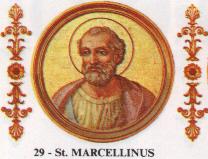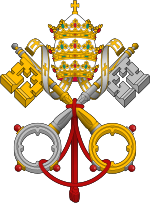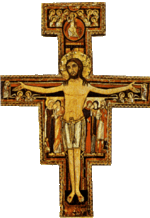Pope Marcellinus
| Saint Marcellinus | |
|---|---|
 |
|
| Papacy began | June 30, 296 |
| Papacy ended | April 1, 304 ? |
| Predecessor | Caius |
| Successor | Marcellus I |
| Personal details | |
| Birth name | Marcellinus |
| Born | ??? ??? |
| Died | April 1, 304 ? Rome, Western Roman Empire |
| Sainthood | |
| Feast day | April 26 |
| Papal styles of Pope Marcellinus |
|
|---|---|
 |
|
| Reference style | His Holiness |
| Spoken style | Your Holiness |
| Religious style | Holy Father |
| Posthumous style | Saint |
Pope Saint Marcellinus, according to the Liberian Catalogue, became bishop of Rome on June 30, 296; his predecessor was Pope St Caius
Marcellinus’ pontificate began at a time when Diocletian was Roman Emperor, but had not yet started to persecute the Christians. He left Christianity rather free and so the church’s membership grew. Caesar Galerius led the pagan movement against Christianity and arrived to bring up Diocletian against Christianity in the year 302: first Christian soldiers had to leave the army, later the Church's property was confiscated and Christian books were destroyed. After two fires in Diocletian’s palace he took harder measures against Christians: they had either to apostatize or they were sentenced to death.
Marcellinus is not mentioned in the Martyrologium hieronymianum, or in the Depositio episcoporum, or in the Depositio martyrum. The Liber Pontificalis, basing itself on the Acts of St Marcellinus, the text of which is lost, relates that during Diocletian’s persecution Marcellinus was called upon to sacrifice, and offered incense to idols, but that, repenting shortly afterwards, he confessed the faith of Christ and suffered martyrdom with several companions. Other documents speak of his defection, and it is probably this lapse that explains the silence of the ancient liturgical calendars. In the beginning of the 5th century Petilianus, the Donatist bishop of Constantine, affirmed that Marcellinus and his priests had given up the holy books to the pagans during the persecution and offered incense to false gods. St Augustine contents himself with denying the affair. The records of the pseudo-council of Sinuessa, which were fabricated at the beginning of the 6th century, state that Marcellinus after his fall presented himself before a council, which refused to try him on the ground that prima sedes a nemine iudicatur ("The first See is judged by none"). According to the Liber Pontificalis, Marcellinus was buried, on April 26, 304, in the cemetery of Priscilla, on the Via Salaria, 25 days after his martyrdom; the Liberian Catalogue gives as the date October 25. The fact of the martyrdom, too, is not established with certainty.
Marcellinus was mentioned in the General Roman Calendar, into which a feast day in his honour jointly with that of Saint Cletus on 26 April was inserted in the thirteenth century.[1] Because of the uncertainties regarding both, this joint feast was removed from that calendar in 1969.[1] Saint Cletus is still listed in the Roman Martyrology under the 26 April date; but Saint Marcellinus is no longer mentioned in that professedly incomplete list of recognized saints.[2]
After a considerable interregnum he was succeeded by Marcellus, with whom he has sometimes been confused.
During the pontificate of Marcellinus, Armenia became the first Christian nation in 301.
References
![]() This article incorporates text from a publication now in the public domain: Chisholm, Hugh, ed (1911). "Marcellinus, St". Encyclopædia Britannica (Eleventh ed.). Cambridge University Press. http://en.wikisource.org/wiki/1911_Encyclop%C3%A6dia_Britannica/Marcellinus,_St.
This article incorporates text from a publication now in the public domain: Chisholm, Hugh, ed (1911). "Marcellinus, St". Encyclopædia Britannica (Eleventh ed.). Cambridge University Press. http://en.wikisource.org/wiki/1911_Encyclop%C3%A6dia_Britannica/Marcellinus,_St.
External links
| Catholic Church titles | ||
|---|---|---|
| Preceded by Caius |
Bishop of Rome Pope 296–304 |
Succeeded by Marcellus I |
|
|||||||||||||||||||||||||||||||||||||||||||||
|
|||||||||||||||||||||||||||||||||||||||||

